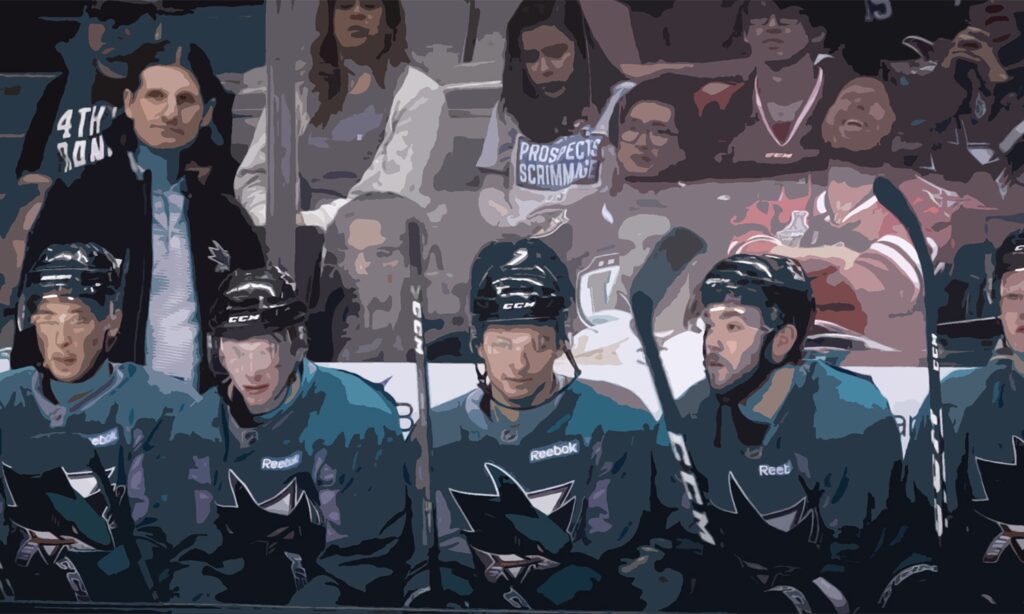Roster sizes vary for every professional team sport.
There are even discrepancies between the active and gameday rosters.
The leagues allow for a small surplus of players in case a last-minute substitutions are in order.
The surplus can allow the coaches to mix up their rosters from game to game.
Maybe the coach doesn’t like what they see and swap one player in for another or their starter is not 100%.
You’ll see this in the baseball (MLB), basketball (NBA) and football (NFL).
The same applies for the National Hockey League.
In hockey, the player benches are quite visible, and the players are lined up like ducks in a row.
There’s typically enough space to seat the whole team, minus those that are on the ice.
Sometimes you’ll see the spare goalie sitting on their own as they do at the Bell Centre in Montreal – by the hallway exit.
And this only applies to the spare goalie from the opposing team.
But before we go any further, let’s start with the burning question…
How many Players on a Hockey Team?
There are 20 players on a hockey team made up of 18 skaters and 2 goaltenders in the NHL. The 18 skaters normally consist of 12 forwards and 6 defensemen, but the coach can modify the balance in each game. The current roster statute has been in effect since the 1982-83 NHL season.
Teams can choose to dress any player from their 23-player active roster, which must always include 2 goaltenders.
The three extra players on the squad are available in case any of the starting players cannot play (due to illness or minor injury).
But the team must submit their gameday roster to the league prior to start time.
Sometimes, the coach will substitute one member of the squad for another in the next game.
As mentioned earlier, the coach might be looking to mix things up or allow for an ailing player to rest. There are a host of reasons they do this, which is not always apparent to media or fans.
On occasion, we’ve seen teams call up a third goalie to join the 23-player active roster.
Assuming the starter and the backup goalies were healthy, the coach could be sending a message.
The problem is that you’re extracting the starting goaltender from an affiliate team. Now, you’re managing three goalies even though only one will likely play the game.
Having 3 goaltenders on your active roster is extremely rare and short lived.
Those extra spots usually comprise of two forwards and one defenseman.
On gameday, sidelined players are seated in the audience, typically in the private section or skybox.
Even if an active player were to go down due to injury, they are not eligible to play for that game.
Beyond the 23-man active roster, the team has a host of other players available to join the team, if necessary.
You’ll see some these players activated should a regular be sidelined for the long term, due to injury.
In fact, the team is allowed a maximum of 50 players under Standard Player Contracts annually.
Most of those additional members play for an AHL-affiliate team or equivalent.
The team manager(s) can swap members from the NHL squad with players on the affiliate teams through a process called waivers.
If you want to better understand how rosters and player contracts are managed at the NHL level, make sure to read my blog post: How Many Players are in the NHL?
How many Players on the ice? (Maximum allowed)
During the game, each team can ice up to 6 players on the ice at any given time. For the most part, the formation consists of 3 forwards, 2 defensemen and a goalie.
The formation may change if a team is assessed a penalty, the game goes to overtime (regular season), the goalie is pulled and so on.
Penalty Kill
Each time a team is called for a minor or major penalty, a player is sent to the penalty box.
The result is that the offending will be down a player, or even two.
Typically, the team will ice two defensemen and two forwards to defend their goalie while shorthanded.
When two players go to the box, the team would ice one forward and two defensemen.
Penalized teams will most often spend time in the defensive zone, due to the numerical advantage awarded to their opponents.
You’ll need your defensemen to protect the front of the net throughout.
Power Play
Nowadays, we tend to see teams play four forwards and one defenseman while on the power play.
The strategy is to increase their chances of scoring by adding an extra attacker on the man advantage.
On the rare occasion, you’ll see 5 forwards and no defensemen at all on the power play.
The standard is to ice three forwards along with your most offensive defensemen during the man advantage.
But let it be known, there is no minimum requirement for the number of forwards or defensemen to be on the ice during play.
Pulling the Goaltender
There are two main occasions when teams pull their goaltender in a match.
During a delayed penalty call against the opposition, or to even the score at the end of the game.
It’s almost always safe to pull the goalie on a delayed penalty call since the second the opposing team touches the puck; the play is blown dead.
The only alarming statement here is “almost always safe”.
That’s because the team ready to go on the power play, can score a goal on their own empty net.
Obviously, it would be by accident, but it has happened in the past.
The purpose of pulling the goalie in the first place is to give themselves a chance to score. You substitute the goaltender for an extra attacker.
How many Players on the ice in Overtime?
When the game is tied after 60 minutes (regulation time), teams play a 5-minute overtime during the regular season.
Since the 2015-16, the NHL changed the overtime format to 3-on-3 in order to increase the chances of scoring.
The player count can change if a team is assessed a penalty during overtime.
As standard practice, the penalized player must go sit in the box. However, rather than resume the game with a 3-on-2 advantage, the NHL (and other leagues) take a different approach.
The shorthanded team would still ice three skaters. It’s the opposition that would add a fourth skater on their side.
If another penalty is called to the same team, it would become a 5-on-3.
Meanwhile, if should the opponents get a penalty (or two), the format would change to a 4-on-4 or possibly 5-on-5.
Regular season overtime is a little quirky at times.
Moreover, teams are allowed to pull their goalie for an extra attacker during overtime.
But it could come at a great price.
Normally, any team that reaches overtime is guaranteed one point in the NHL standings.
Should the opposition score on the empty net, the losing team would forfeit the extra point towards the standings.
Do as you please, but you were warned of the consequence. Those extra points can be the difference in qualifying or missing out on playoffs.
Speaking of playoffs, the overtime period is not structured in the same way as the regular season.
When the game remains tied, teams play sudden death overtime.
That is, the next team to score will win the game. The overtime periods are each 20 minutes long.
Furthermore, the overtime period is played 5-on-5 unless penalties are assessed.
What is the least number of Players allowed on the ice?
At any given time during the game, the least number of players a team can ice is four.
Typically, this would be three skaters along with a goalie.
However, anything can happen, and that goalie could be pulled for a fourth skater.
I have yet to see the goalie come out either in regular season overtime or when a team is down two men.
Exceptions to Gameday Roster Count (EBUG)
The gameday roster count is not entirely limited to 20 players. There happens to be a possible exception to the rule.
If, and only if, both your starting and backup goalies get injured, the league allows for an emergency backup.
An emergency backup goalie, or EBUG for short, is someone at the venue prepared to play in nets for either team, if needed.
This person typically has goaltending experience but is not active or signed to any league.
It’s likely they’ve played at a high level in the past but have long retired from the sport.
In any case, the team sign them on the spot to a one-day contract and have them fill the net for the balance of the game.
Usually, they’d be given advance notice to suit up with a goalie going down unexpectedly on gameday. However, I’ve witnessed both the starter and backup go down while the match was in progress.

If you’d like to read up on this, check out this recap from the Toronto Maple Leafs vs Carolina Hurricanes game back in 2020.
Spoiler Alert. David Ayres, 42, was the Zamboni driver for Toronto’s affiliate AHL team.
When both Hurricanes’ goalies, Petr Mrazek and James Reimer went down in the game, Ayres helped fill the void.
Essentially, he defended the net against his own team. To add insult to injury, the Hurricanes won the game.
90-Player Reserve List
Before we end things off, I wanted to mention one last roster limitation set by the NHL: the 90-player Reserve List.
This list is made up of the 50 players signed to a Standard Player Contract and any unsigned players.
For example, draft pick players fall under this category as they are unsigned, but their rights still belong to the team.
NHL Roster Limit Recap
To recap, there are four roster limits that the league has in place: Gameday Roster, Active Roster, Standard Player Contract and Reserve List.
The gameday and active rosters are usually filled to capacity throughout the season.
Sometimes you’ll have management leave spots vacant due to salary cap constraints.
As for Standard Player Contracts and Reserve Lists, they are almost never maxed out.
Take the Standard Player Contract limit as an example. By leaving some open spots, it allows the organization the flexibility to make roster moves such trades, waiver claims and player signings.
NHL Roster Limits Table
| Roster Limits | Count Per Team | Total (32 teams) | Notes | |
|---|---|---|---|---|
| 1 | Gameday Roster | 20 | 640 | The maximum number of players that can dress for the game, which must include two goalies. |
| 2 | Active Roster | 23 | 736 | The daily limit of players that can practice with the team |
| 3 | Standard Player Contract | 50 | 1600 | The annual limit of players that can be signed to that specific organization. |
| 4 | Reserve List | 90 | 2880 | The annual limit of both signed and unsigned players in which their rights belong to the organization. |
Final Thoughts
Asking about the no. of players on a hockey team can lead you down a rabbit hole.
I think the average person really wants to know either how many players are on the ice at once or the full gameday roster.
When you see a bench full of players squeezed like sardines in a can, the count immediately sparks your curiosity.
So, let’s crunch the numbers based on the evidence.
At the start of the game, there are 6 players on the ice for each team.
The gameday roster count is set to twenty players typically made up of 12 forwards, 6 defensemen and 2 goalies.
That would mean each bench is occupied by 14 players, at once, for most of the game.
Unless, of course, the game reaches overtime (regular season).
With the format being 3-on-3, your team must now squeeze in two extra players on the bench.
And to make matters worse, if the game goes to shootout, only the active shooter is permitted on the ice for each round.
That bench must be jammed packed by the end.
In fact, I went to make sure by checking out some shootout highlights on YouTube.
Those team benches look extremely uncomfortable.
But for the salary that they earn, I’d cozy up with my teammates too.






